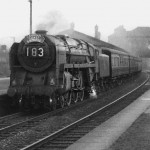The end was in 1964/5. I should know: I have the last Ian Allan Combined Volume that had WR steam in it. I had moved to Dorset from Keynsham in 1962 and before I went, I had seen the last remnants of steam followed by the invasion of the Warships. As a child I was excited by those diesels even as I was sad about losing steam and, as my book records, I copped all of them. Down on the Castle Cary to Weymouth line there was still the odd Grange and Hall for a while until those were gone too and we settled for that meagre diet of Hymeks and endless DMUs instead.
It did all seem a little premature but what would have happened if steam had lingered until, say, 1980? I am not sure it would have made any difference to the GWR engines we so loved. The last Castles out of Worcester, the ones with double chimneys and mechanical lubricators etc might have survived until about 1975 but the cull of the old stock of GWR locos would have continued. The 28xx, the great survivors from 1906, would have been finally made extinct by growing numbers of 9Fs; Britannias would have doubled their numbers, Standard 4s and 5s would have been everywhere and Standard designs in general would have eliminated almost all of the real GWR designs within a couple more years. Perhaps 94xxs and the late 32xxs might have hung on too. It is known that another crop of Clans were nearly ordered for the S&D (this was what was behind the trial of 9Fs on that line, then in the not entirely trustworthy hands of the WR) so a Standardised GWR would have been likely in the last 15 years.
And they may have gone into ‘rail blue’ livery, I imagine! I do not know of many GWR loco owners brave enough to have a go at this but I did once see 1369 in pale blue undercoat at Buckfastleigh and someone had painted the double arrow on it. It didn’t look completely terrible!
I don’t think the survival of steam would have allowed many of the Beechinged branch lines to survive either. It has taken until now for the huge uptake in rail travel and cost reducing technologies to make some of these lines an economic proposition.
I guess one change might have been that the WR might have made a better fist of its dieselisation policy. The Swindon insistence on ‘doing it different’ might have led to the early termination of the Diesel Hydraulic experiment (shades of the Broad Gauge there, I have always felt). A Hymek was, by most accounts, not much better than a good ‘Hall’ and Warships never an improvement on Castles or Kings and all were unreliable, so if steam had clung on for a while, we might have never got to the Westerns.
Would the GWR locomotive works have survived? Wolverhampton? Almost certainly not. Swindon? Well just maybe it might have kept the wheels turning just long enough to have been bought by someone like Siemens or Alstom. One thing I am sure of, if Swindon Works had held on by its finger tips, it would be facing a very strong future in the new rail industry.
Still, the GWR is very much alive in spirit. Volunteers keep the heritage alive and everyone involved in the future of Mr Brunel’s network still talks of ‘The Great Western’ but it has to keep evolving, however much we may lament the loss of the old railway in our hearts. Will those SET’s be chocolate and cream, I wonder…
